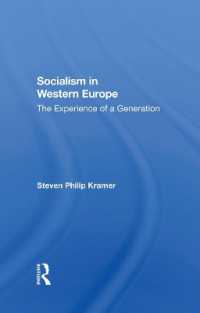- ホーム
- > 洋書
- > 英文書
- > Science / Mathematics
Full Description
Ask not what science can do for you, but what public history can do for science!
Interpreting Science in Museums and Historic Sites stresses the untapped potential of historical artifacts to inform our understanding of scientific topics. It argues that science gains ground when contextualized in museums and historic sites. Engaging audiences in conversations about hot topics such as health and medical sciences or climate change and responses to it, mediated by a history museum, can emphasize scientific rigor and the time lag between discovery and confirmation of societal benefit. Interpreting Science emphasizes the urgency of this work, provides a toolkit to start and sustain the work, shares case studies that model best practice, and resources useful to facilitate and sustain a science-infused public history.
Contents
Contents
Foreword
Jill Tiefenthaler, Chief Executive Officer, National Geographic Society
Preface by Karen-Beth G. Scholthof
Acknowledgments
Part I - Science, the Public Historian and Museum Collections
Introduction
Chapter 1: Communicating Climate Change with Archives of Nature and Archives of
Societies by Sam White
Chapter 2: Creating Public Space for Complex Conversations by Melanie Armstrong
Chapter 3: (Re)constructing the Past: Research and Science Interpretation in Experimental
Archeological Open-Air Museums by Claus Kropp
Chapter 4: Local Weather, Distant Connections: Interpreting Meteorological
Instruments and Data by Roger Turner
Chapter 5: Medical Science Archives: Closer and More Accessible Than They Might
Appear by April White and David D. Vail
Part II - Science and the Human Experience
Introduction
Chapter 6: From Farm to Table: A One-Health Scenario by Karen-Beth G. Scholthof
Chapter 7: Seeing the Museum in the Garden: Using Living History Museums to
Teach the History of Plant Introductions by Emily Pawley
Chapter 8: The Outdoor Life: Seeking the "Cure" in New Mexico by Karen-Beth G.
Scholthof
Chapter 9: "...In the Interest of the Health Conservation of the American Negro":
National Negro Health Week, 1915-1951 by Cherisse Jones-Branch
Chapter 10: Irrigation History: Moving Water from Colorado Mountain Peaks to
Fruited Plain by Patricia Rettig
Chapter 11: Exporting the "Wonders of Modern Science": Thinking Scientifically
About Food Aid and Foreign Policy by Kristin Ahlberg
Part III - Science: A Culture of Doubt? A Culture of Questioning
Introduction
Chapter 12: Reflecting on Uncomfortable Science by Aimee Slaughter
Chapter 13: For Our Own Protection: On Black Gay Males and HIV/AIDS Activism by
Jajuan S. Johnson
Chapter 14: Becoming a Scientist: Untangling the Roles of Chemistry Sets
by Debra A. Reid
Chapter 15: The "Gene Gun" and Genetic Engineering: Unpacking the Science by Karen-
Beth G. Scholthof and Debra A. Reid
Chapter 16: Know your analyst, know your food? by Benjamin R. Cohen
Chapter 17: Science and Progress in the Kitchen: Forks, Eggbeaters, and Sporks by
Karen-Beth G. Scholthof and Debra A. Reid
Part IV - Science and History Museum Education
Introduction
Chapter 18: Integrating Art and Science to Effectively Share Knowledge by Bethann
Garramon Merkle
Chapter 19: School Gardens and Edible Education by Debra A. Reid
Chapter 20: A Yearbook of Science for the Public Good by David D. Vail
Chapter 21: Interpreting Scientists: An Interview with Storyteller Brian "Fox" Ellis
Chapter 22: Design, Science, and Driven to Win: A History Museum Addresses the
Innovation Opportunity Gap by Robert Oleary and Matt Anderson
Chapter 23: Exploring Science with Young Naturalists by Debra A. Reid
Conclusion
IDEAS: Inclusion, Diversity, Equity and Access to Science by Karen-Beth G. Scholthof
Selected Readings
Timeline
Contributors
Index






